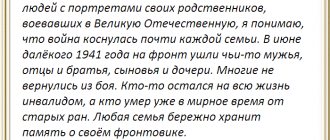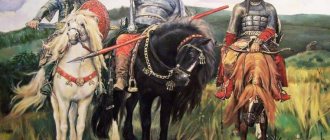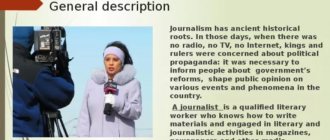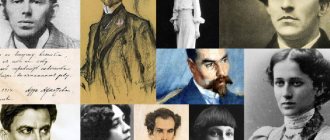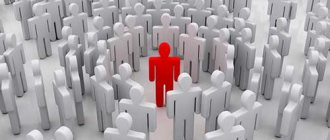Essay on the topic “What is creativity”
The world is beautiful! Every day we are pleased with its uniqueness. Creativity is life. The best human qualities are manifested in him: hard work, kindness, responsiveness, humanity, nobility. Creativity is impossible without inspiration, which helps it develop and improve. A creative person is always interesting. His activities are aimed at creating original materials, products of his labor, and a unique result. Fantasy, invention, imagination, and ingenuity are clearly manifested in creativity.
The creations of the soul inspire spiritually! The light of the Universe flows in them, multi-colored rainbows shimmer, orange sunrises shine. Creative people decorate the world with their intellectual and manual inventions. At all times, beautiful poetry, artistic works of art, brilliant musical masterpieces, magnificent work of folk craftsmen, masters of Russian original and decorative arts were famous. People who have experience in handicrafts create beautiful things: they engage in knitting, embroidery, beading, wood carving, painting dishes and toys in Khokhloma, Gzhel, Dymkovo. Vologda lace, which is woven by craftswomen using special bobbins, has long been famous in Rus'.
Does your teacher check for plagiarism? Order a unique work from us for 250 rubles
Connect with us:
Creativity gives talent to those who are truly gifted! It is limitless, free, and has high moral and aesthetic value. The mystery of creativity is in its striving for ideal, perfection, truth. Not everyone can experience its power. Only a select few can rise to the pinnacle of success and illuminate the world with the radiant stream of their unsurpassed skill.
The poetry and prose of Marina Tsvetaeva is a golden treasury of world literature. Her works fascinate with their lyrical content and deep philosophical meaning. They contain many epithets, beautiful figures of speech, comparisons, and wise thoughts. The creative path of the poetess was not easy, full of life drama. She lived, defeating time. This was the secret of her great creations.
Tsvetaeva paid great attention to earthly days and hours, living several lives in them at once. In the poem “Praise of Time,” the poetess glorifies life running through time. She was different: sensitive, kind, romantic, moving from one extreme to another. Her work is the law of life, which reflects joys, sadness, ups and downs. Marina Tsvetaeva was a poetess of Space and the Universe. Her essays about art, poetry, books, geniuses, and God are interesting. For her, creativity is a “state of obsession”, “obsession” and “possession”, “dream”. Poems for her were the key to understanding the world.
Dedications to Anna Akhmatova, Vladimir Mayakovsky, Alexander Blok, Osip Mandelstam, Vyacheslav Ivanov and Prince Mikhail Volkonsky are filled with a feeling of love and respect for friends and compatriots. The lyrics dedicated to daughters Alya and Irina are touching. She idolized her name in poetry and compared it to the sea. Her soul, name and dreams were marine. The poetess was a wizard with her amazing works!
Creativity is incomprehensible! It gives birth to gifted and talented people who realize their goals, deeds, and successes. It contains the great power of art! Creativity is the shining of stars, blooming gardens, the fragrance of the first spring flowers and sunlight that gives warmth. This is joy, illuminated by the rays of spirituality and a flight to infinity! Thanks to the creative process, we realize ourselves in various fields of activity, learn to create beauty and love the world! This is why man was born on earth! His mission is creative progress!
Psychology of creativity. Essay
tags:
Creative, Creativity, Ability, Thinking, Psychology, Personality, Man, Obstacle Psychology of creativity. Essay.
- Introduction.
Creativity is an important part of every person's life, and creative thinking is a unique ability that distinguishes humans from animals. It is creative thinking that is the driving force for development and improvement, both of an individual and of all humanity. The main goal and result of human creative activity is the creation of something objectively new that has not been created before. If people didn’t have such an ability as creative thinking, most likely we would still live in caves and kill mammoths with stones. After all, everything familiar that surrounds us now is to some extent a product of creativity. Both the table, and the chair, and various gadgets were invented and created by humanity, and are culture, in the broad sense of the word. Thus, it is difficult to downplay the importance of creative thinking in our lives. And the psychology of creativity is precisely that branch of psychology that studies the process of creativity, the characteristics of creative thinking, barriers to creativity and looks for ways to overcome these barriers.
It is not difficult to explain why I was interested in this particular research topic. From an early age I have been interested in the work of such famous artists, poets and writers as Ivan Aivazovsky, Valentin Serov, Marina Tsvetaeva, Anna Akhmatova, Ivan Bunin and many others, so for me research on the psychology of creativity is an excellent opportunity to better understand what was driving the strength of these great men as they created famous works.
The relevance of the topic of this work is beyond doubt. The question of creative thinking has been relevant at all times. Even long before the transformation of psychology into an independent science, attempts were made to explain the phenomenon of creative thinking, and research in this area of knowledge still does not stop. But, of course, the psychology of creativity is not limited to the official framework of science. It covers our entire life. After all, almost every day we meet on the street or at home, at work or school, in a museum or on the Internet with various works of art: paintings, architectural structures, sculptures, poems or stories. And the psychology of creativity will not only help society understand how they were created, but will also explain how to become a creator yourself.
9 pages, 4488 words
Topic 1. Psychology of thinking 2
.. But there are no sailors themselves either: the ship had to be invented sometime, to solve the problem “how to sail across the sea-ocean, unless you are a fish-whale.” The cat also cried about cars and motorcycles: whatever one may say, inventing a wheel is a cool problem, because in nature there are no wheels... Can you come up with something that does not exist in nature? Why did they have to invent a wheel?... Well, how do you like this...
Creative thinking is becoming increasingly valuable to the individual in an age when the importance of individualism and uniqueness is growing. “Don’t be like everyone else” is the motto of modern man. Then a person faces the question: How to overcome conformity and become a creative person?
So, the purpose of my research is to identify ways to stimulate creative thinking.
In my research I set the following tasks:
- Outline the characteristics of a creative personality.
- Consider the stages of the creative process.
- Explore barriers to creativity.
- Find a solution to overcome these obstacles.
The object of this study is creative thinking.
The subject of the study is a creative personality.
The research method is the study of various materials on this topic: psychological theories, surveys, experiments.
- Creation. Features of a creative personality.
At the beginning of the study, it is necessary to decide what we mean by the basic concepts of work “creativity” and “creative personality”. What kind of person can be called a truly creative person?
By the term “creativity” scientists understand the process of activity that creates qualitatively new material and spiritual values. The main criterion that distinguishes creativity from manufacturing is the uniqueness of its result. That is, no one except the author can get exactly the same result if the same initial situation is created for him. For example, in a kindergarten, ten children were given the same task: to draw a house (initial condition), but none of the children would produce exactly the same drawings (results).
Thus, in the creative process, the author invests certain personal properties and abilities into the material. That is why they say that the creator puts his soul into his work. This fact of uniqueness gives creative products additional value in contrast to manufactured products. The psychology of creativity identifies the following types of creativity: production and technical, inventive, scientific, political, philosophical, artistic, everyday and so on, that is, types of creativity correspond to types of practical and spiritual activity.
Based on the foregoing, we can conclude that a creative person, in the broadest sense, is a person who has creative thinking and has developed creative abilities that allow him to create new things without much effort. On the issue of the emergence of creative thinking and creative abilities in psychology, there are two main opinions: the ability to be creative is an innate property of an individual or it is an acquired ability that can be developed. But there is also an opinion that combines two extremes: creative abilities are determined by inclinations, but largely depend on how the individual will develop them. And I agree with this opinion. If an individual has a predisposition to any creative activity, then by improving his abilities in this area, he can develop them to the level of talent or even genius. For example, the famous poet and writer A.S. Pushkin, in order to rightfully be called a genius of Russian literature, worked a lot, wrote a lot, constantly developing his talent. Otherwise, the individual loses the ability to be creative and think creatively.
9 pages, 4279 words
Folklore as a special form of creativity
... the identity of the author was of no interest, which is why the memory of her was not preserved. Thus, the idea of “collective” creativity... the re-actualization of poetic_facts is much lower. If all the bearers of a well-known creative tradition have died, then it can no longer... be a collective. Supporters of the thesis about the individual nature of folklore creativity tend to substitute anonymous instead of collective. For example, …
In the psychology of creativity, there are many criteria for creativity - the ability to think creatively. Thus, in Gestalt psychology the following requirements for the mental makeup of the creator were considered mandatory:
- do not be limited, blinded by habits;
- do not simply and slavishly repeat what you have been taught;
- do not act mechanically;
- do not take a partial position;
- do not act with attention focused on a limited part of the problem structure;
- not to act with partial operations, but to operate freely with the situation, with a mind open to new ideas, trying to find its internal relationships.
In other words, a creative person must think independently and consider the situation as a whole, without singling out individual elements.
American psychologist Guilford Joy Paul identifies the following criteria for creative thinking:
- ability to detect and pose problems;
- ability to generate a large number of ideas;
- flexibility - the ability to produce a variety of ideas;
- originality – the ability to respond to stimuli in a non-standard way;
- the ability to improve an object by adding details;
- ability to solve problems, i.e. abilities for synthesis and analysis.
Another psychologist A. Olah points out the following personality traits inherent in creative people:
- independence – personal standards are more important than group standards,
- non-conformity of assessments and judgments
- openness of mind - willingness to believe one’s own and others’ fantasies,
- receptivity to the new and unusual;
- high tolerance to uncertain and insoluble situations,
- constructive activity in these situations;
- developed aesthetic sense, desire for beauty.
In psychology, there are many other classifications of criteria for creative thinking, but, in essence, they are all similar: the main thing is that a creative person has non-standard thinking and is not influenced by stereotypes.
- The creative process and barriers to it.
Each psychologist identifies the stages of creative thinking in his own way. For example, Henri Poincaré, in his report to the Psychological Society in Paris (in 1908), described the process of making several mathematical discoveries and identified the stages of this creative process, which were subsequently identified by many psychologists:
- Preparation - formulating the task; attempts to solve it. Poincaré describes this stage as follows: “I tried to prove that there could be no function analogous to the one that I later called automorphic... every day I sat down at my desk, spent an hour or two at it, exploring a large number of combinations, and did not come to no result."
- Incubation is a temporary distraction from a task. At this time, Poincaré believes, unconscious work on the task occurs.
- Insight is the emergence of an intuitive solution. This is the moment when suddenly, without immediately preceding thoughts about the problem, in a random situation that has nothing to do with the problem, the key to the solution appears in the mind.
- Validation - testing and implementation of the solution. When the key idea for the solution is already known, the solution is completed.
P. M. Yakobson (1934) identified the following stages:
1 page, 206 words
Differences between a qualified psychologist and an unqualified one
2. Routinely evaluates the client’s actions. 3. There is no understanding of what interpersonal influence is. Worldview Understands the complexity of his work, strives to understand and use many ways to help the client. Does not reflect on the topic of work, is limited to one way of helping the client. Understanding foreign culture Able to perceive and understand foreign culture. Able to work only within the framework...
- The period of intellectual readiness.
- Discretion of the problem.
- The origin of the idea is the formulation of the problem.
- Finding a solution.
- Obtaining the principle of the invention.
- Transforming a principle into a scheme.
- Technical design and deployment of the invention.
There are many ways to distinguish stages, but here, too, common features can be identified. In general, we can say that the creative process is divided into theoretical and practical parts: first, the idea is conceived and processed in the mind of the individual, and then it is translated into reality. For example, before we draw a picture, we first see its image in our head.
So what stops many people from developing and using their creative thinking? The psychology of creativity tries to answer this question. The main factors that interfere with creative thinking include conformism, external and internal censorship, rigidity and the desire to find an answer immediately.
Now let's look at each factor separately. Conformal behavior –
a moral-political and moral-psychological concept denoting opportunism, passive acceptance of the existing social order, political regime, etc., as well as a willingness to agree with prevailing opinions and views, general sentiments widespread in society. How K. is also regarded as non-resistance to prevailing trends, despite their internal rejection, self-withdrawal from criticism of certain aspects of socio-political and economic reality, reluctance to express one’s own opinion, refusal of any responsibility for actions taken, blind submission and adherence to any requirements and instructions, coming from the state, society, party, leader, religious organization, patriarchal community, family, etc. (such submission may be due not only to internal beliefs, but also to mentality and tradition).
The phenomenon of conformist behavior plays a negative role in creativity. This behavior is caused both by the individual properties of the individual and by interpersonal relationships in the creative team, moreover, by the characteristics of the social environment in the broad sense of the word.
6 pages, 2912 words
Behavior as a psychophysiological phenomenon
...motivations. Among the different types of behavior, we highlight social behavior. Human behavior can be social or antisocial. Social behavior is a person’s behavior in society, designed to provide... A set of actions that do not correspond to the norms and principles established in society form deviant behavior. In real life,...
In a number of artistic and philosophical-critical works, the social environment acts as a hostile force in relation to creatively gifted people. Society’s hostility to the manifestation of creative abilities is reflected in the words of the protagonist of Diderot’s work Rameau’s Nephew, who declared: “People of genius are disgusting; and if any child is born with the characteristic marks of this dangerous gift on its forehead, it should either be strangled or thrown out to be devoured by dogs.” Argentine psychologist J. Ingenieros in his book “Mediocrity” justifies this attitude, characterizing it as protective, and therefore useful for society.
imagination…
Examples of similar educational works
Development of musical and creative abilities of children of middle preschool age in...
... development of musical and creative abilities in psychological and pedagogical research The concept of abilities, the idea of their variability, was introduced into science by Plato. He was the first to develop the most fundamental theory of creativity. The source of creative impulse...
TRIZ as a means of developing the creative abilities of preschool children
... non-trivial ideas, the development of creative and strong thinking, the formation of creative individuals and teams, proof that creativity can and should be taught. TRIZ as a means of developing the creative abilities of preschool children...
Formation of creative abilities of schoolchildren in the learning process 2
... is creativity. A creative person can secure for himself not only a worthy place in society, but also contribute to the progress of society itself. One of the most difficult issues in solving the problem of developing students’ creative abilities...
Development of creative abilities in primary school students through music.
... with the creative development of personality, primarily the personality of the child, such outstanding researchers as L.S. Vygotsky, B.M. Teplov, K. Rogers, P. Edwards; - research directly related to the problem of creative abilities, such...
Development of creative abilities of preschool children in the process of getting acquainted with nature
... preschool children 1.1. The concept of creative abilities in psychological and pedagogical research According to the requirements of the Federal State Educational Standard for preschool education, the problems of developing the creative abilities of a growing individual in modern conditions have ...
Work program of the discipline Psychology of Creativity
...diagnostic tools within the framework of the psychology of creativity Proficient in: self-diagnosis of creative potentials, culture of creative thinking 2. Structure and content of the discipline psychology of creative abilities General labor intensity of the discipline ...
